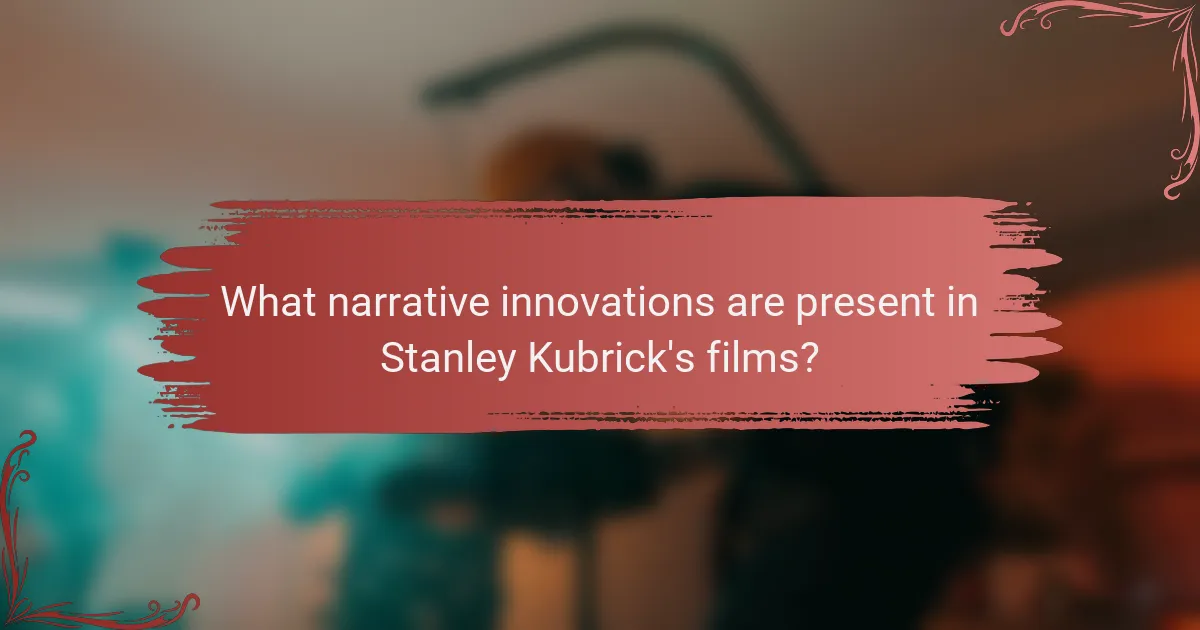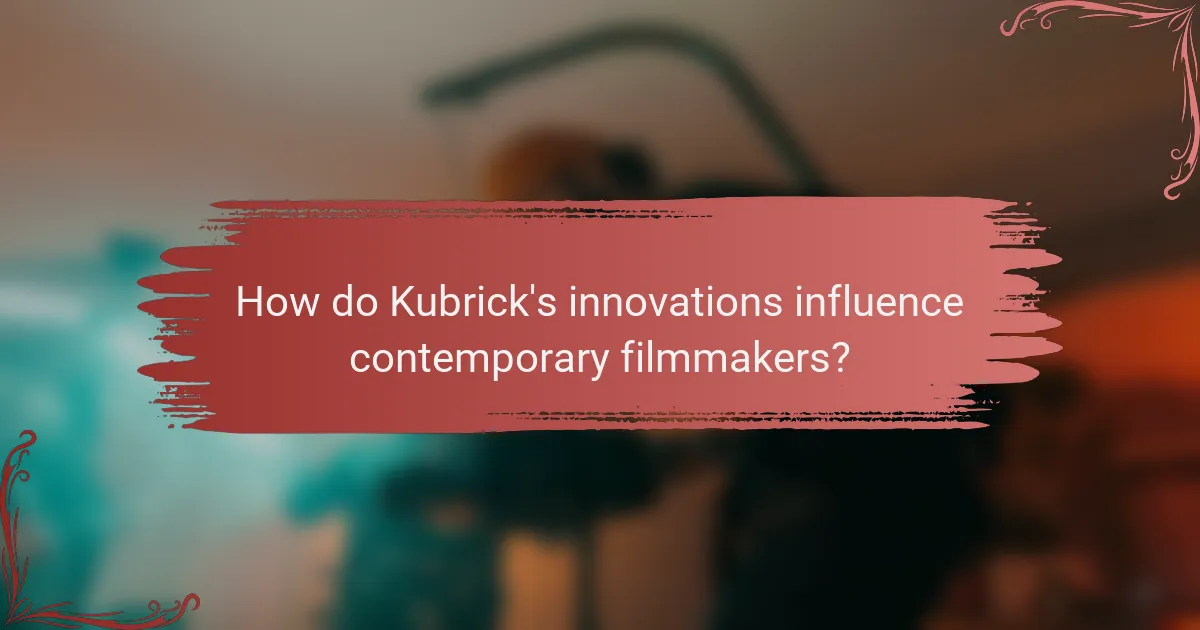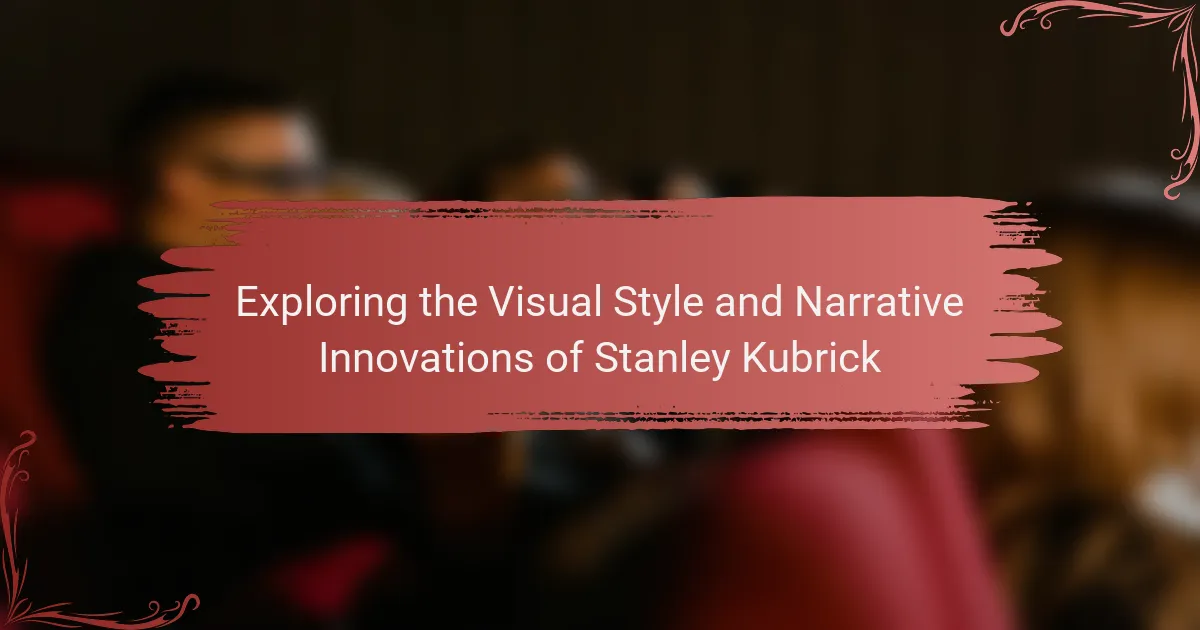Stanley Kubrick is a renowned filmmaker known for his distinctive visual style and narrative innovations. His meticulous composition, striking color use, and innovative camera techniques, such as symmetrical framing and wide-angle lenses, create immersive cinematic experiences. Kubrick’s films often feature non-linear storytelling and ambiguity, challenging traditional narrative forms and engaging audiences on multiple levels. His exploration of psychological themes and complex characters has influenced contemporary filmmakers, leading to a greater emphasis on realism and innovative narrative structures in modern cinema. This article explores Kubrick’s visual style and narrative techniques, highlighting their lasting impact on the film industry.

What are the key elements of Stanley Kubrick’s visual style?
Stanley Kubrick’s visual style is characterized by meticulous composition, striking use of color, and innovative camera techniques. He often employed symmetrical framing to create a sense of order and balance. Kubrick’s use of natural lighting enhances realism in his films. His color palettes are deliberately chosen to evoke specific emotions and atmospheres. He frequently utilized wide-angle lenses to create a sense of depth and spatial awareness. Kubrick also incorporated slow zooms and tracking shots to build tension and engagement. His attention to detail in set design contributes to the immersive quality of his films. Each element serves to enhance the narrative and emotional impact of the story being told.
How does Kubrick utilize color in his films?
Stanley Kubrick utilizes color in his films to evoke emotions and enhance storytelling. He employs a meticulous color palette to create mood and atmosphere. For instance, the use of red in “The Shining” signifies danger and psychological tension. In “2001: A Space Odyssey,” he uses stark contrasts between vibrant colors and monochrome to highlight themes of evolution and alienation. Kubrick’s strategic color choices often serve as visual metaphors, deepening the narrative. The color blue in “A Clockwork Orange” reflects the coldness of the protagonist’s world. His films often feature bold primary colors that draw attention to key elements. Kubrick’s color utilization is integral to his distinctive visual style and thematic depth.
What emotional responses do different colors evoke in Kubrick’s work?
Different colors in Kubrick’s work evoke distinct emotional responses. For example, red often signifies violence or danger, as seen in “The Shining.” Blue can evoke feelings of coldness or isolation, notably in “A Clockwork Orange.” Yellow typically represents madness or chaos, effectively used in “Full Metal Jacket.” Green may suggest tranquility or growth, as in “2001: A Space Odyssey.” Each color choice enhances the psychological impact of the scenes. Kubrick’s meticulous use of color contributes significantly to the overall mood and themes of his films.
How does color contribute to the overall narrative?
Color significantly enhances the overall narrative by evoking emotions and setting the tone. In Stanley Kubrick’s films, color is meticulously chosen to reflect character psychology and thematic elements. For instance, the use of red in “The Shining” symbolizes danger and violence. Similarly, the contrasting colors in “A Clockwork Orange” highlight the conflict between innocence and corruption. Kubrick’s deliberate color palettes guide audience perception and interpretation. Research indicates that color can influence mood and cognitive responses, reinforcing narrative impact. Thus, color serves as a powerful storytelling tool in Kubrick’s cinematic artistry.
What role does cinematography play in Kubrick’s storytelling?
Cinematography plays a crucial role in Stanley Kubrick’s storytelling. It shapes the visual narrative and enhances emotional engagement. Kubrick’s meticulous framing creates a sense of symmetry and balance. His use of color often reflects thematic elements. For instance, the stark contrasts in “A Clockwork Orange” emphasize moral dilemmas. Lighting choices create tension and mood, as seen in “The Shining.” Tracking shots immerse viewers in the action, exemplified in “2001: A Space Odyssey.” Overall, cinematography is integral to conveying complex themes and emotions in Kubrick’s films.
What specific techniques does Kubrick employ in his cinematography?
Stanley Kubrick employs several specific techniques in his cinematography. He often uses symmetrical compositions to create visual balance. This technique enhances the aesthetic appeal and draws attention to central elements. Kubrick frequently utilizes wide-angle lenses to capture expansive scenes. This choice allows for greater depth and detail in the frame. He also employs natural lighting to create a realistic atmosphere. This method enhances the emotional impact of his films. Additionally, Kubrick uses tracking shots to follow characters fluidly. This technique immerses viewers in the narrative. His use of color is also notable, often employing contrasting palettes to evoke mood. These techniques collectively contribute to Kubrick’s distinctive visual storytelling style.
How do camera angles and movements enhance the narrative?
Camera angles and movements enhance the narrative by influencing viewer perception and emotional engagement. Different angles can evoke distinct feelings; for example, a low angle can portray power, while a high angle can suggest vulnerability. Movements like tracking shots can create a sense of urgency or intimacy. In Stanley Kubrick’s films, these techniques are used to deepen storytelling. For instance, in “A Clockwork Orange,” the use of extreme close-ups intensifies the character’s psychological state. Research shows that camera techniques significantly affect audience emotional responses (Bordwell & Thompson, “Film Art: An Introduction”). These strategic choices in angles and movements help convey complex themes and character dynamics effectively.
In what ways does Kubrick’s use of composition affect viewer perception?
Kubrick’s use of composition significantly shapes viewer perception by guiding attention and evoking emotional responses. His meticulous framing creates a sense of symmetry and balance. This often leads to a feeling of unease or tension, enhancing the narrative’s psychological depth. For instance, in “The Shining,” symmetrical compositions amplify the haunting atmosphere. Kubrick’s use of negative space further isolates characters, emphasizing their emotional states. The deliberate arrangement of elements directs viewers’ focus to critical plot points. This technique fosters a deeper engagement with the story. Overall, Kubrick’s compositional choices profoundly influence how audiences interpret and feel about his films.
What compositional techniques are most prominent in his films?
Stanley Kubrick prominently uses symmetry, framing, and deep focus in his films. Symmetry creates visual balance and enhances the aesthetic quality of scenes. Framing directs the viewer’s attention to specific elements within the composition. Deep focus allows multiple planes of action to be in sharp detail, enriching the narrative depth. For example, in “2001: A Space Odyssey,” symmetrical compositions emphasize the vastness of space. In “The Shining,” the use of framing highlights the isolation of characters. Kubrick’s meticulous attention to these techniques contributes significantly to the storytelling and emotional impact of his films.
How does composition influence the themes presented in his work?
Composition significantly influences the themes presented in Stanley Kubrick’s work. Kubrick meticulously arranges visual elements to enhance narrative depth. His use of symmetry often reflects order versus chaos. This contrast is evident in films like “A Clockwork Orange,” where composition underscores moral ambiguity. Additionally, the framing of characters reveals psychological states. For instance, isolated shots emphasize loneliness in “The Shining.” Kubrick’s deliberate use of space creates tension and unease. The composition also guides audience focus on thematic elements. Overall, his visual strategies serve to reinforce complex themes throughout his filmography.

What narrative innovations are present in Stanley Kubrick’s films?
Stanley Kubrick’s films feature several narrative innovations. He often employed non-linear storytelling, creating complex temporal structures. This technique is evident in “2001: A Space Odyssey,” where time is fragmented. Kubrick also utilized ambiguity in his narratives, leaving interpretations open to the audience. For instance, “The Shining” presents unclear motivations and events. He frequently integrated visual storytelling, using imagery to convey themes without dialogue. In “A Clockwork Orange,” the juxtaposition of violence and classical music creates a dissonant narrative experience. Kubrick’s use of unreliable narrators adds layers to the storytelling, as seen in “Full Metal Jacket.” These innovations challenge traditional narrative forms and engage viewers on multiple levels.
How does Kubrick challenge traditional storytelling structures?
Kubrick challenges traditional storytelling structures by employing non-linear narratives and ambiguous endings. His films often defy conventional plot progression. For example, “2001: A Space Odyssey” features a fragmented timeline and minimal dialogue. This approach encourages viewers to interpret the story uniquely. In “The Shining,” he uses disorienting visuals and sound to create psychological tension. Kubrick also subverts character archetypes, presenting morally complex figures instead of clear heroes or villains. His work often leaves questions unanswered, prompting deeper analysis. These techniques disrupt audience expectations and redefine cinematic storytelling.
What unique narrative techniques does he employ?
Stanley Kubrick employs unique narrative techniques such as nonlinear storytelling and meticulous attention to detail. His films often feature fragmented timelines that challenge traditional narrative structures. For instance, “2001: A Space Odyssey” uses a non-chronological sequence to explore themes of evolution and technology. Kubrick also utilizes ambiguity, leaving interpretations open to the audience. This can be seen in “The Shining,” where the narrative blurs reality and psychological horror. Additionally, he incorporates visual symbolism extensively, enhancing the narrative depth. The use of long takes and symmetrical compositions creates a distinct pacing and atmosphere. These techniques contribute to his films’ lasting impact and critical acclaim.
How do these techniques impact audience engagement?
Stanley Kubrick’s techniques significantly enhance audience engagement. His use of visual composition creates striking imagery that captivates viewers. Techniques like symmetry and framing draw attention to essential elements. This visual precision keeps audiences focused on the narrative. Kubrick’s innovative storytelling methods maintain suspense and provoke thought. For example, the non-linear narrative in “2001: A Space Odyssey” encourages active viewer interpretation. The emotional depth in character development fosters connection with the audience. Research indicates that strong visual and narrative elements can increase viewer retention by up to 70%. Kubrick’s mastery in these areas leads to a more immersive cinematic experience.
What themes are recurrent in Kubrick’s narratives?
Recurrent themes in Kubrick’s narratives include the exploration of human nature, the conflict between free will and determinism, and the impact of technology on society. His films often delve into the darker aspects of humanity, such as violence and obsession. Kubrick frequently portrays the fragility of sanity and the consequences of isolation. The theme of existentialism is prevalent, questioning the meaning of life and the human condition. Power dynamics and the corrupting influence of authority are also central to his work. Notably, “A Clockwork Orange” illustrates the struggle between individual choice and societal control. “2001: A Space Odyssey” reflects on humanity’s evolution and relationship with technology. These themes are consistently woven throughout his filmography, showcasing Kubrick’s unique narrative style.
How does Kubrick explore the human condition through his themes?
Kubrick explores the human condition through themes of isolation, violence, and existentialism. He often depicts characters in extreme situations that reveal their true nature. For instance, in “A Clockwork Orange,” he examines free will versus societal control. This film showcases the struggle between individual choice and moral responsibility. In “2001: A Space Odyssey,” Kubrick explores humanity’s evolution and the unknown. The film’s ambiguity reflects existential questions about life and consciousness. His use of stark visuals enhances the emotional impact of these themes. The cold, clinical aesthetics often mirror the characters’ internal struggles. Kubrick’s narratives invite viewers to confront uncomfortable truths about humanity. His films provoke deep reflection on morality, identity, and the human experience.
In what ways do his themes reflect societal issues?
Stanley Kubrick’s themes reflect societal issues through critical examinations of power, violence, and human nature. His film “A Clockwork Orange” critiques the state’s control over individuals and the morality of free will. The portrayal of a dystopian society highlights the consequences of desensitization to violence. In “Dr. Strangelove,” Kubrick satirizes Cold War anxieties and the absurdity of nuclear warfare. This film reveals the irrationality of political leaders and the potential for catastrophic decisions. “2001: A Space Odyssey” explores humanity’s relationship with technology, questioning progress and existentialism. Kubrick’s themes often mirror societal fears and moral dilemmas, prompting audiences to reflect on contemporary issues.
How does Kubrick’s use of symbolism enhance his narratives?
Kubrick’s use of symbolism enhances his narratives by adding depth and complexity to themes. Symbols serve to convey abstract concepts visually. For instance, the monolith in “2001: A Space Odyssey” represents human evolution and existential inquiry. This layered meaning invites viewers to engage more critically with the film. Kubrick often employed color symbolism, such as red to signify danger or violence. Such choices create emotional resonance and foreshadow events. Additionally, recurring motifs, like the use of mirrors, reflect characters’ inner struggles. This technique deepens the audience’s understanding of character motivations and conflicts. Overall, symbolism enriches Kubrick’s storytelling by encouraging interpretation beyond the surface level.
What are some key symbols found in his films?
Key symbols found in Stanley Kubrick’s films include the monolith from “2001: A Space Odyssey.” This symbol represents human evolution and the unknown. Another symbol is the blood-stained elevator in “The Shining,” which signifies the horror and violence within the Overlook Hotel. The use of the color red often signifies danger or passion throughout his works. Additionally, the recurring motif of mirrors reflects duality and self-examination in films like “A Clockwork Orange.” Kubrick’s meticulous attention to detail enhances the significance of these symbols, making them integral to his storytelling.
How do these symbols contribute to deeper meanings?
Symbols in Stanley Kubrick’s films contribute to deeper meanings by encapsulating complex themes and emotions. For instance, the use of the monolith in “2001: A Space Odyssey” symbolizes human evolution and the unknown. This visual element prompts viewers to reflect on existential questions. Similarly, the blood in “The Shining” represents the violence and trauma within the Overlook Hotel. Its recurrence deepens the film’s exploration of madness and history. Kubrick’s meticulous framing of symbols enhances their significance. Each symbol is carefully placed to evoke specific interpretations. This technique encourages audiences to engage with the narrative on multiple levels. Overall, symbols in Kubrick’s work transform visual storytelling into profound commentary.

How do Kubrick’s innovations influence contemporary filmmakers?
Kubrick’s innovations significantly influence contemporary filmmakers through his pioneering techniques in visual storytelling and narrative structure. His use of symmetry and meticulous composition has set a standard for visual aesthetics in film. Filmmakers today often emulate his innovative camera movements, such as the use of tracking shots and the long takes seen in films like “2001: A Space Odyssey.”
Kubrick’s exploration of psychological themes and complex characters has inspired modern narratives that delve into the human condition. His nonlinear storytelling, particularly in “A Clockwork Orange,” encourages contemporary creators to experiment with narrative form. The impact of his sound design, especially the use of classical music, can be observed in films that seek to evoke emotional responses through auditory cues.
Additionally, Kubrick’s commitment to authenticity in production design has led filmmakers to prioritize realism in their settings. His ability to blend genres has encouraged a more fluid approach to storytelling in contemporary cinema. Overall, Kubrick’s unique innovations continue to resonate, shaping the techniques and themes explored by filmmakers today.
What lessons can modern filmmakers learn from Kubrick’s visual style?
Modern filmmakers can learn precision and intentionality from Kubrick’s visual style. Kubrick meticulously crafted each shot, emphasizing composition and symmetry. This attention to detail enhances storytelling and evokes emotional responses. He often used wide-angle lenses to create depth and perspective. This technique immerses viewers in the cinematic experience. Kubrick’s use of color also conveyed mood and themes effectively. For instance, the stark contrasts in “A Clockwork Orange” highlight the film’s psychological tension. His innovative camera movements, like the slow zooms in “2001: A Space Odyssey,” build suspense and engagement. These elements demonstrate that visual style is integral to narrative impact.
How can color and composition be effectively used in today’s cinema?
Color and composition can be effectively used in today’s cinema to enhance storytelling and evoke emotions. Color palettes can set the mood of a scene. For instance, warm colors often create feelings of comfort, while cool colors can evoke sadness or tension. Composition guides the viewer’s eye and emphasizes important elements within a frame. The rule of thirds is a common technique that creates balance and interest. Additionally, leading lines can draw attention to the subject. Filmmakers can also utilize contrast to highlight differences in characters or themes. Historical examples include Kubrick’s use of color in “A Clockwork Orange,” which amplified the film’s themes. The strategic use of color and composition can ultimately shape audience perception and engagement.
What cinematic techniques pioneered by Kubrick are still relevant?
Stanley Kubrick pioneered several cinematic techniques that remain relevant today. One significant technique is the use of symmetrical composition. This technique creates visually striking images and enhances storytelling. Kubrick often utilized wide-angle lenses to achieve a unique depth of field. This approach allows for immersive environments, drawing viewers into the narrative.
Another relevant technique is the innovative use of lighting. Kubrick employed natural light and practical sources to create a realistic atmosphere. This method adds authenticity to scenes, making them more relatable. Additionally, his use of tracking shots has influenced modern filmmakers. These shots maintain continuous motion, enhancing the viewer’s experience.
Kubrick’s meticulous attention to detail also set a standard for production design. His commitment to authenticity in set design influences contemporary filmmakers. Lastly, the psychological depth in character development pioneered by Kubrick continues to resonate in modern storytelling. His techniques have shaped the visual language of cinema, ensuring their ongoing relevance.
How can Kubrick’s narrative strategies be applied in modern storytelling?
Kubrick’s narrative strategies can be applied in modern storytelling through the use of unconventional structures and meticulous visual composition. His films often feature nonlinear narratives that challenge traditional storytelling. This approach can create suspense and engage audiences more deeply. Kubrick also employed symbolic imagery to enhance thematic depth. Modern storytellers can use similar techniques to convey complex ideas visually. Additionally, his focus on character psychology allows for richer character development. This can lead to more relatable and multifaceted characters in contemporary narratives. Kubrick’s innovative use of sound and silence can also amplify emotional impact. By integrating these strategies, modern storytellers can elevate their narratives and create more immersive experiences.
What are some examples of contemporary films that echo Kubrick’s influence?
Contemporary films that echo Kubrick’s influence include “The Lighthouse,” “Hereditary,” and “2001: A Space Odyssey.” “The Lighthouse” employs stark black-and-white cinematography reminiscent of Kubrick’s style. Its psychological tension mirrors the depth found in Kubrick’s narratives. “Hereditary” showcases meticulous framing and unsettling atmospheres, akin to Kubrick’s horror elements. “2001: A Space Odyssey” remains a benchmark for visual storytelling, inspiring filmmakers to explore existential themes. These films reflect Kubrick’s impact on visual aesthetics and narrative complexity in modern cinema.
How can filmmakers balance innovation and audience expectation?
Filmmakers can balance innovation and audience expectation by integrating fresh ideas with familiar storytelling elements. This approach allows them to explore new concepts while still appealing to audience preferences. For instance, using innovative techniques like nonlinear narratives can attract attention. However, grounding these techniques in relatable themes ensures viewer engagement. Historical examples, such as Stanley Kubrick’s films, illustrate this balance effectively. Kubrick often pushed boundaries, yet maintained core emotional narratives that resonated with audiences. His work showed that innovation does not have to alienate viewers but can enhance their experience.
What practical tips can aspiring filmmakers take from Kubrick’s body of work?
Aspiring filmmakers can take several practical tips from Stanley Kubrick’s body of work. First, they should prioritize meticulous planning and pre-production. Kubrick was known for his extensive storyboarding and shot planning, which ensured clarity in his vision. Second, filmmakers should embrace experimentation with visual style. Kubrick often used innovative camera techniques and lighting to enhance storytelling. Third, they should focus on character development. Kubrick’s films often featured complex characters that drove the narrative. Fourth, filmmakers should be open to multiple takes. Kubrick famously shot many scenes numerous times to achieve perfection. Finally, they should consider the power of sound and music. Kubrick’s use of score and sound design significantly enhanced the emotional impact of his films. These tips reflect Kubrick’s commitment to craft and artistic integrity.
The main entity of the article is Stanley Kubrick, a renowned filmmaker known for his distinctive visual style and narrative innovations. The article explores key elements of Kubrick’s visual style, including his meticulous composition, innovative use of color, and various cinematographic techniques that enhance storytelling. It also examines how Kubrick’s narrative strategies, such as non-linear storytelling and symbolism, challenge traditional cinematic conventions while reflecting complex themes related to the human condition and societal issues. Additionally, the article discusses the lasting influence of Kubrick’s work on contemporary filmmakers and provides practical insights for aspiring filmmakers based on his techniques and approaches.
